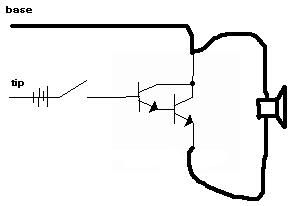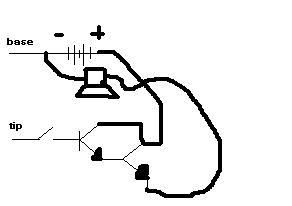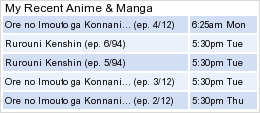A quick trip to radioshack would help

; you can buy either some amps there or some transistors (which would be cheaper, and you really wouldn't lose much quality if you're using this 'thing' with your calc only; otherwise, some amps would provide better quality) I'll look up what parts you'll need.
>Transistors<
It's a pack of 15 NPN transistors; since this is your first time doing something like this, I suggest you get this pack (just in case you blow up a few of them

)
>Audio Amps<
Get this only if you plan on using this speaker for anything other than your calc and quality is an issue.
Also foamy, what spare electronic components do you have lying around?
You'll also need a power supply (4 AAAs or AAs will do it) and a resistor or two.

When playing music on a calc, both data lines on the linkport used right? Because if they are, and foamy has a speaker and a piezo, he
could get stereo sound

Ultimate Dev'r wrote:
A quick trip to radioshack would help

; you can buy either some amps there or some transistors (which would be cheaper, and you really wouldn't lose much quality if you're using this 'thing' with your calc only; otherwise, some amps would provide better quality) I'll look up what parts you'll need.
>Transistors<
It's a pack of 15 NPN transistors; since this is your first time doing something like this, I suggest you get this pack (just in case you blow up a few of them

)
>Audio Amps<
Get this only if you plan on using this speaker for anything other than your calc and quality is an issue.
Also foamy, what spare electronic components do you have lying around?
Well, do you remember that first pic I posted of the piezo in the handheld game? I have that one and another of the exact same game still whole. (I got two for christmas from different people. They were cheap  ) I also have an old fm radio. I could probably take apart one of my portable cd-players, too.
) I also have an old fm radio. I could probably take apart one of my portable cd-players, too.
EDIT: I was looking at transistor schematics, but they all are a lot more complicated than my design. How would I need to set it up? I don't understand how the transistor has 3 prongs. Does the positive end of the battery go to the base and the negative go to the emitter? And where does the collector go? And should the transisitor be between the battery positive side and the speaker?
What you should do then is take the two piezos out of the two handhelds that you got for Christmas and use them instead of that big-@$$ speaker that you got at Wal-Mart.
Ultimate Dev'r wrote:
What you should do then is take the two piezos out of the two handhelds that you got for Christmas and use them instead of that big-@$$ speaker that you got at Wal-Mart.
You don't like the big-@$$ speaker? What downfalls does it have? Does it just require too much power?
Well, it's a little overkill...

But it's cool!

Foamy, there's more to electronics than positive and negative.

You need a biasing resistor on one leg of the transistor, other end of that goes to power (+), a second leg of the transistor goes to ground (-) and a third is input. You also need to tie in the output to the first pin before the biasing resistor.
Don't feel bad about not knowing about electronics. Most of us have been working with them for years. It's ok.
In essence, Foamy, all you need for a simple Bridge-Junction Transistor (BJT) amplifier is this:

KermMartian wrote:
But it's cool!

Foamy, there's more to electronics than positive and negative.

You need a biasing resistor on one leg of the transistor, other end of that goes to power (+), a second leg of the transistor goes to ground (-) and a third is input. You also need to tie in the output to the first pin before the biasing resistor.
What is a biasing resistor?
EDIT: Would this work?

EDIT2: I'm going to radioshack tomorrow. Are those transistors all I need?
Almost. You need to connect tip directly the BJT input, base to the battery's negative AND one terminal of the speaker, and the other terminal of the speaker to the output. Then conncet the positive of the battery to the top of the BJT schematic, and you should be set.

?
*bump*

I built this with 3AAA batteries. I don't have any resistors so I was afraid to hook it up to my calc, but I used it with my cd. The quality went waaaay down, but I'm pretty sure it's louder. It constantly cuts out. It really only plays whenever there is a really big bass beat. Any ideas on why it won't play the rest of the songs?
When you do get resistors, put one right after the switch (I estimate around 1K ohm should do the trick)
Also, can you tell us the part number/brand of the speaker you're using?
Ultimate Dev'r wrote:
When you do get resistors, put one right after the switch (I estimate around 1K ohm should do the trick)
Also, can you tell us the part number/brand of the speaker you're using?
By after the switch, you mean between the switch and the transistors, right?
And it is a Durabrand DB35 3.5" Polypropylene Dual-Cone Speaker.
Heavy Duty 5oz. Magnet
8 Watts RMS @ 1KHz
25 Watts Max.
Quote:
By after the switch, you mean between the switch and the transistors, right?
Yes.
Quote:
And it is a Durabrand DB35 3.5" Polypropylene Dual-Cone Speaker.
Heavy Duty 5oz. Magnet
8 Watts RMS @ 1KHz
25 Watts Max.
Well there's your problem; do you really expect to run something like that off of a few AAA's?! 
(Sorry, I forgot you n00b status for a sec there...hell, none of us knew the specs for that speaker until now)
I strongly suggest that you use those two piezo's for speakers; it makes life soooo much simpler 
Ultimate Dev'r wrote:
Quote:
By after the switch, you mean between the switch and the transistors, right?
Yes.
Quote:
And it is a Durabrand DB35 3.5" Polypropylene Dual-Cone Speaker.
Heavy Duty 5oz. Magnet
8 Watts RMS @ 1KHz
25 Watts Max.
Well there's your problem; do you really expect to run something like that off of a few AAA's?! 
(Sorry, I forgot you n00b status for a sec there...hell, none of us knew the specs for that speaker until now)
I strongly suggest that you use those two piezo's for speakers; it makes life soooo much simpler 
I replaced the speaker with a pizzo but I'm having the same problem. It only makes a noise on beat. I've been testing it through the headphone port on my comp speakers. It plays almost constantly if you turn the volume up the whole way (same as with the speaker). Do you think the 3AAAs are still not enough, even for the piezzo?
note: I only used one piezzo, not two. And I used the exact same hookup for the piezzo as the speaker. I just unhooked the speaker and hooked up the piezzo with the same wires. I didn't change anything else.
What do you mean by 'only on a beat'? As in you can't hear vocals if played from your computer?
Try hooking some C or D batteries up to that; I bet the AAAs can't handle the amperage the speaker is trying to draw.
Register to Join the Conversation
Have your own thoughts to add to this or any other topic? Want to ask a question, offer a suggestion, share your own programs and projects, upload a file to the file archives, get help with calculator and computer programming, or simply chat with like-minded coders and tech and calculator enthusiasts via the site-wide AJAX SAX widget? Registration for a free Cemetech account only takes a minute.
»
Go to Registration page
You cannot post new topics in this forum
You cannot reply to topics in this forum
You cannot edit your posts in this forum
You cannot delete your posts in this forum
You cannot vote in polls in this forum
 ; you can buy either some amps there or some transistors (which would be cheaper, and you really wouldn't lose much quality if you're using this 'thing' with your calc only; otherwise, some amps would provide better quality) I'll look up what parts you'll need.
; you can buy either some amps there or some transistors (which would be cheaper, and you really wouldn't lose much quality if you're using this 'thing' with your calc only; otherwise, some amps would provide better quality) I'll look up what parts you'll need.
 )
)
 ; you can buy either some amps there or some transistors (which would be cheaper, and you really wouldn't lose much quality if you're using this 'thing' with your calc only; otherwise, some amps would provide better quality) I'll look up what parts you'll need.
; you can buy either some amps there or some transistors (which would be cheaper, and you really wouldn't lose much quality if you're using this 'thing' with your calc only; otherwise, some amps would provide better quality) I'll look up what parts you'll need.



















